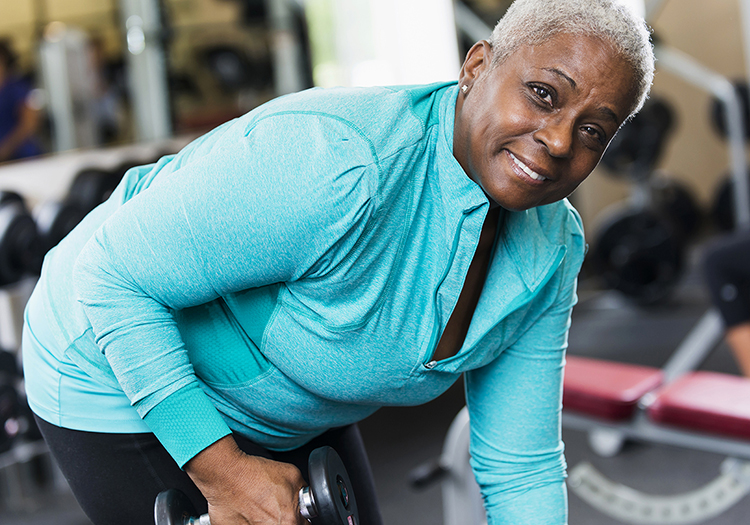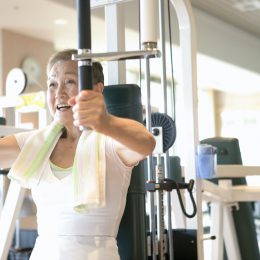How to Start Exercising When You Have 25+ Pounds to Lose
Your step-by-step guide to shedding significant weight safely and sustainably.

Starting a new exercise routine is never easy. Whether you want to lose the last five pounds or the first 25, you always need three key ingredients: motivation, effort, and a plan.
All three are important, but when you have a lofty weight loss goal—especially later in life—the plan is paramount. That’s true for a couple reasons. First, once you have a solid strategy in place, the other two factors are much easier to come by. And second, when you’re losing weight, it’s important to make sure you’re losing it primarily from fat, not muscle, says Josh Hillis, C.P.T., a performance specialist and author of Fat Loss Happens on Monday.
That second point is even more important because muscle loss tends to increase and metabolism tends to decrease with age, Hillis says.
But like most things that are challenging, getting to a healthy weight is worth the effort, no matter your age. Research shows that, even for men and women in their eighth decade, healthy weight loss can improve cardiovascular health, insulin sensitivity, and mobility—all things that contribute to living a longer, happier life.
If you’re ready to make a change, you’ve come to the right place. Here are six smart strategies for shedding significant weight sustainably.
Step #1: Call on the Experts
“The first step is to get permission from your doctor to exercise,” says Jessica Cording, R.D., a weight management specialist. “Let your doc know that you’re thinking of getting back into fitness and losing weight. That way, you two can come up with a course of action with your health in mind.”
Factors such as your heart and joint health can influence what types of exercise are safe and healthy for you. If you have diabetes, you’ll also want to talk to your doctor about the best way to manage blood sugar during exercise.
“If your back, knee, shoulder, or other body parts hurt on a regular basis, you should make an appointment with a physical therapist,” Hillis says. “A physical therapist can help you rehab old injuries and set you up for pain-free sessions in the gym.”
A certified personal trainer or group classes led by instructors trained to work with older adults, like SilverSneakers, can also help you learn proper form and gain confidence in your exercise abilities. Tell trainers and instructors about any conditions, injuries, or concerns you have so they can tailor moves for your needs.
Step #2: Make “Slow and Steady Wins the Race” Your Mantra
“Substantial weight loss will not happen instantly,” Hillis says. “It happens over the course of a few months or even a few years.”
When older adults have a lot of weight to lose, they often go too hard too soon, he adds. The unfortunate result: They get so sore that they’re turned off by exercise altogether—or worse, they end up injured.
A better approach: Each week, focus on doing a little more than you did the previous week. Over time, you’ll be able to steadily improve your fitness without overstressing your body, Hillis says. Plus, if you feel like exercise is building you up rather than breaking you down, you might actually like it!
Step #3: Prioritize Muscle-Building Activities
According to a review in Age and Ageing, one out of every three older adults suffers from severe muscle loss, or sarcopenia. This muscle loss can contribute to fat gain.
What’s more, when you lose weight, your body naturally loses a portion of it from muscle. That’s something you want to minimize, Hillis says. And if you can actually build muscle while losing weight, even better. His recommendation: Spend the bulk of your workout engaged in muscle-building activities.
Not sure where to begin? Consider working with a trainer who can help you come up with a strength program that takes any injuries, mobility limitations, or muscle imbalances into consideration, Hillis suggests. “And don’t assume that bodyweight exercises are the best place for you to start,” he adds. “Sometimes cable machines and TRX bands are a great choice for older adults because they don’t require that you get down on the floor like, say, a pushup does.”
Learn more in our beginner’s guide to strength training. It has everything you need to know to approach strength training in a safe, effective, and fun way that will keep you strong for life.
Step #4: Make Walking Part of Your Daily Routine
“Walking is one of the most accessible, easy-on-the-joints fitness activities you can do every day,” Hillis says. And it’s effective: A recent British study found people who regularly walked for fitness weighed less than those devoted to other types of physical activity, including running, swimming, and cycling.
Start by walking five to 10 minutes, three times per day, recommends Lisa Niren, C.P.T., a fitness expert in New York City. These simple strategies to walk more each day can help.
Subscribe to our newsletter
It's quick and easy. You could be one of the 13 million people who are eligible.
Already a member? Click to discover our 15,000+ participating locations.
Follow Us
Once you’ve got the hang of that, increase your exercise duration until you’re walking for 30 minutes at a time, Niren says. Keep your pace comfortably challenging. If you can carry on a lengthy conversation without effort, it’s time to speed up. Need inspiration? Find free walking programs on the SilverSneakers GO app (iOS and Android).
Step #5: Celebrate Non-Scale Victories
Most experts consider losing about one pound per week to be healthy, maintainable, and realistic, Hillis says. “So if you’re losing two to four pounds per month, you’re doing great!” Still, slow progress can dampen motivation.
Instead of getting hung up on the scale when you’re exercising for weight loss, pay attention to other payoffs associated with your new, more active lifestyle, Cording says. Maybe it’s sleeping better, walking up the stairs without getting winded, or being able to get up from a chair with ease, she says. “Those are all signs that what you’re doing is improving your life.” And that’s what this is really all about, right?
For more convincing reasons to keep moving, check out our guide to 17 ways exercise benefits your body and brain—beyond weight loss.
Step #6: Remember That Exercise Is Just One Part of Losing Weight
“Exercising can’t be your only method of losing weight,” Hillis says. As the saying goes, “you can’t out-exercise a bad diet.” What you eat impacts your workouts and weight, he says. Other factors: your sleep habits, stress levels, and emotional health.
That’s actually good news. “Thinking of exercise as just one part of your new, healthier lifestyle can help take the pressure off of your workouts,” Hillis says. To help round out your routine, check out these great resources:
- 9 Things You Should Never Do When Starting a Diet
- 5 Ways to Fall and Stay Asleep—Starting Tonight!
- A Simple Trick to Reduce Stress in Less Than 60 Seconds
Take Your Favorite SilverSneakers Classes Online!
SilverSneakers members can access live fitness classes and wellness workshops through SilverSneakers LIVE. See the latest schedule and RSVP for classes here.
Not a member? If you have a Medicare Plan, it may include SilverSneakers—at no additional cost. Check your eligibility instantly here.





